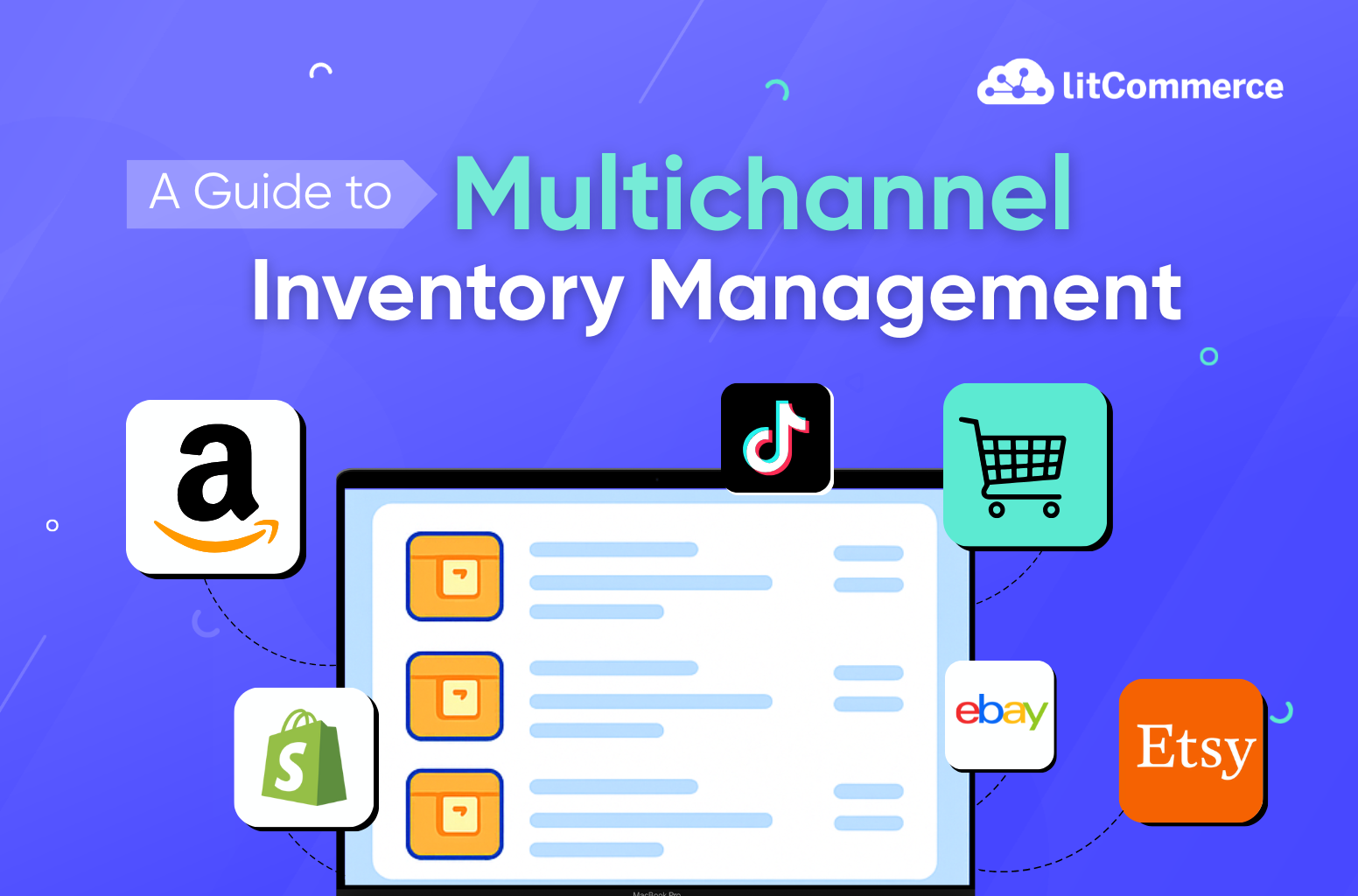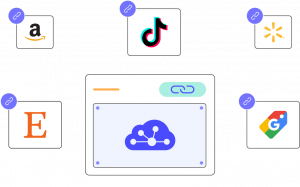Ever sold out on one platform but forgot to update stock on another? You’re not alone. Overselling and inventory mismatches are common nightmares for sellers, especially if you’re managing a mix of brick-and-mortar stores, online shops, marketplace listings, and even social media storefronts.
Relying on paper logs, spreadsheets, or occasional stock counts isn’t that effective and often leads to disappointed customers and wasted resources. That’s why multichannel inventory management is essential for today’s retailer. It helps you track and control stock across all your sales channels, helping you avoid missed sales, stockouts, or unhappy customers.
In this guide, let’s discover everything you need to know about multi-platform inventory management, including:
- What multichannel inventory management is and why it matters
- How to manage stock across multiple channels effectively
- The best tools to simplify your inventory tracking
Let’s get into it!
Take Multichannel Inventory Management to the Next Level!
With LitCommerce, you can sync inventory across multiple channels, from Shopify to eBay, Etsy, TikTok, and more. Keep your stock updated everywhere & avoid overselling.
What is Multichannel Inventory Management?
Multichannel inventory management is the process of tracking and managing your stock across multiple sales channels you sell on through a single system. Instead of managing separate inventories for your physical retail store, eCommerce website, marketplace stores, and shops on social media, everything stays connected and updated in real time.
For example, imagine you sell gaming products on Shopify, eBay, and TikTok Shop. When someone buys a game station on eBay, your stock automatically updates on Shopify and TikTok Shop too. That means no overselling, no guesswork, and no frustrated customers.
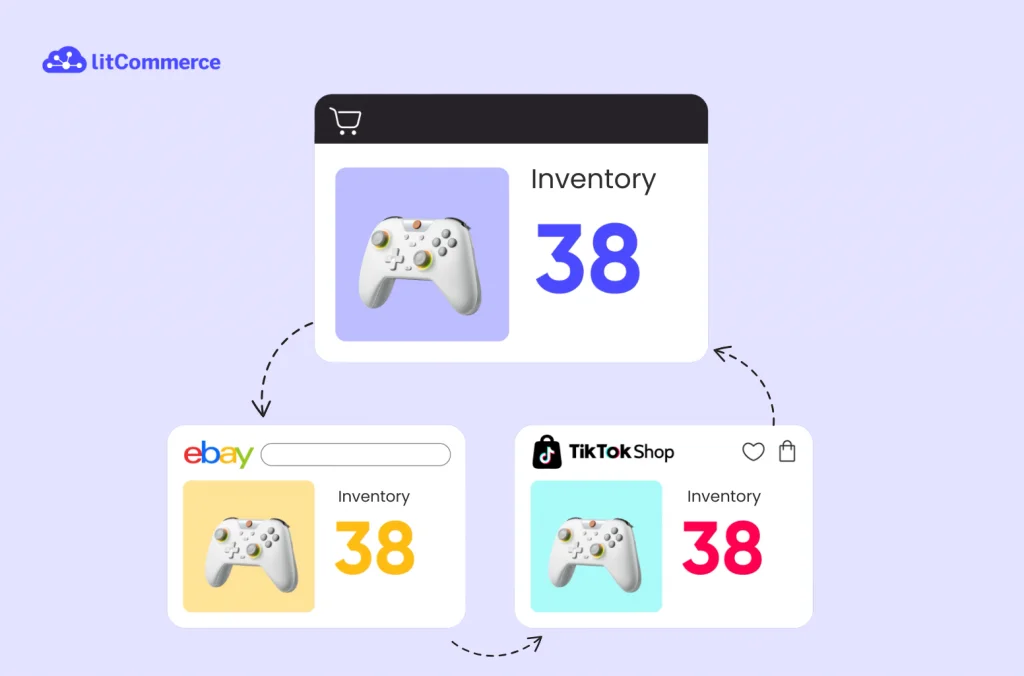
With this cloud-based multichannel inventory management system, you get one accurate source of truth for all your inventory data. It gives you real-time visibility into stock levels, helps you handle sudden spikes in demand (like a viral TikTok moment), and keeps your business running smoothly across every platform, online or offline.
Managing inventory across different sales channels is just one part of running a successful multichannel business. To get the full picture, explore our complete multichannel selling guide.
4 Benefits of Multichannel Inventory Management
Managing your stock across many platforms can be tricky, but an efficient multichannel inventory system can make it much simpler. Here are the top benefits of multichannel eCommerce inventory management:
1. Real-time visibility & inventory sync
With multichannel inventory management, you get a clear, up-to-the-minute view of your stock across every sales channel. Whether it’s Shopify, Amazon, or your brick-and-mortar store, your inventory updates automatically the moment a customer makes a purchase.
This real-time visibility and inventory sync not only helps you avoid manual errors but also saves hours spent on updating and managing stock.
2. Prevention of overselling & stockouts
Real-time inventory updates also help you avoid selling products that are already out of stock, which can damage customer trust. They also let you predict and prevent stockouts more accurately, especially reducing lost sales during peak seasons or with best-selling products.
According to a McKinsey report, poor inventory management can cut profits by up to 10% due to missed sales and inefficient stock control.
3. Improved customer experience
Imagine this: a shopper visits your store and buys the last bottle of your best-selling moisturizer. Minutes later, another customer orders the same product online, not knowing it’s already sold out. Without real-time updates, that second order ends in disappointment and a potential lost customer.
Real-time multichannel inventory then makes sure situations like this never happen. Moreover, you can direct shoppers to the nearest store that has the item or ship from the closest warehouse to speed up delivery. The result is a smoother shopping experience, fewer cancellations, and happier, more loyal customers.
Great inventory management also means delivering consistent support wherever your customers shop. Learn how to offer seamless, cross-platform support on multichannel customer service.
4. Centralized insights
Another major benefit of multichannel inventory management is having one centralized dashboard to track stock across all your sales channels. With valuable insights gathered in one convenient place, you can easily spot trends, restock best-sellers, and forecast demand more accurately.
How to Manage Inventory Across Multiple Channels?
Managing inventory across different platforms may sound tricky, but with the right tools, it becomes effortless. The key is using a cloud-based multichannel inventory system that connects all your sales channels from your online store to your retail POS, marketplaces, and social shops.
When you make a sale, process a return, or receive new stock, your inventory should update automatically everywhere. That means if someone buys an item from your website or TikTok Shop, your stock on Amazon, eBay, and in-store adjusts in real time. This automatic sync keeps everything accurate and eliminates the need for manual updates.
A centralized inventory dashboard also makes it easier to stay on top of your stock. You can see what’s selling fast, where you’re running low, and which location has extra inventory. Many systems even let you:
- Track stock levels across multiple warehouses or stores.
- Set low-stock alerts to restock bestsellers before they sell out.
- Redistribute inventory based on demand or seasonal trends.
By keeping your sales channels connected and your data synced, you’ll reduce errors, save time, and deliver a smoother experience for both your team and your customers.
Keep Your Stock Updated Everywhere!
Use LitCommerce to connect all your selling platforms. When you make a sale, your inventory updates automatically across every channel – simple, fast, and stress-free.
What to Look For In a Multichannel Inventory Management Software
When choosing a multichannel inventory management tool, go for one that makes managing stock simple and includes features designed to help your business grow.
Here are some key factors to consider when choosing a multichannel inventory management software:
- Sales channels: First and foremost, your multichannel inventory management tool should support your sales channels. Some tools might support your retail POS, while others mainly support online platforms.
- Integration: Choose software that syncs seamlessly with your sales channels and fulfillment centers to keep stock data consistent everywhere.
- Automation: You also should look for a tool with automatic stock updates, low-stock alerts, and purchase order generation to save time and prevent errors.
- Analytics: Real-time insights into inventory, pricing, and sales trends help you make smarter restocking and pricing decisions.
- Ease of Use: Choose a system with a clean, user-friendly, intuitive dashboard that’s easy for your team to learn and manage, especially when you want to search for products in your inventory.
Top 5 Multichannel Inventory Management Software
Using a Google Sheets inventory template is a common starting point for multichannel sellers. But compared to a dedicated multichannel inventory management app, spreadsheets spreadsheets work best only for small catalogs and low order volumes.
So with the above factors, we have compiled a list of the 5 best multichannel inventory management software for your consideration:
1. LitCommerce
If you’re selling across multiple channels, like your own online store built on Shopify or WooCommerce, plus marketplaces such as eBay, Etsy, or Walmart, and even social platforms like TikTok Shop or Facebook, then LitCommerce is the tool you’ve been looking for.
LitCommerce is a powerful yet easy-to-use multichannel listing and inventory management software that helps you manage everything, listings, inventory, and orders, from a single, unified dashboard.
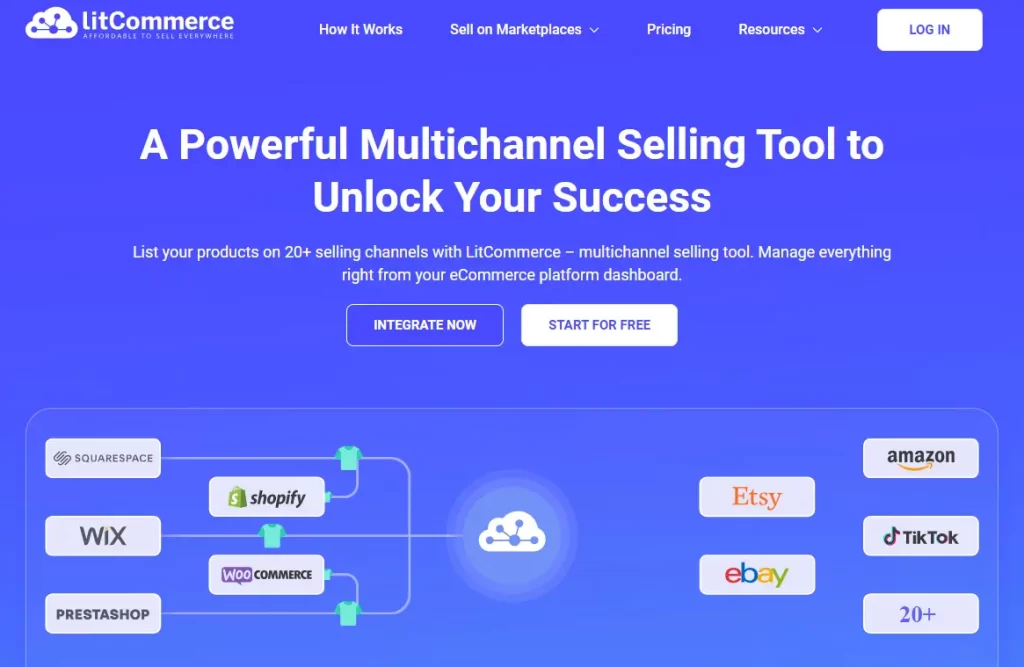
Selling on Shopify and want to explore more tools like this? Check out our guide on: Best Shopify inventory management apps!
With LitCommerce, you can:
- Multichannel integration: Connect your online store, marketplaces, and social channels all in one place. This allows you to manage your listings and inventory across all your sales channels from a single place.
- Inventory sync: LitCommerce synchronizes your inventory levels across every connected channel. You can even set custom rules for each marketplace to prevent overselling or underselling.
- Order centralization: View and manage all your orders from one dashboard, making fulfillment faster and more organized.
- Listing management: You can create, edit, and publish listings in bulk, saving you time while keeping your product details consistent everywhere.
Manage your inventory across channels easily
Let multichannel inventory management software like LitCommerce work for you. Synchronize and automatically update your inventory on all channels.
2. Brightpearl
Brightpearl is a specialized system designed for stores that sell online and in physical shops, catering to medium to large retailers. It streamlines operations, enhances sales, and ensures customer satisfaction through smart order management.
With Brightpearl, you can effortlessly use Magento, BigCommerce, Shopify, Amazon, and eBay alongside your physical stores—all in one place. The system’s real-time POS integration provides a clear picture of your business operations.
In addition, Brightpearl offers advanced features like FBA inventory management, real-time Amazon inventory tracking, demand planning, warehouse management, and insights into Amazon profitability. This comprehensive solution adapts to your business needs, providing flexibility and the ability to scale up with ease, ensuring your business stays competitive in the dynamic e-commerce landscape.

3. SkuNexus
At SkuNexus, we believe that inventory management is the keystone of all other business operations. If you don’t know what you have and where you have it, right now, managing inventory across various online platforms and marketplaces becomes a guessing game.
To address this, SkuNexus designs its systems to empower merchants with an array of tools providing total command, clear visibility, and complete control of their entire inventory in real time.
4. Ecomdash
Ecomdash is a handy tool that helps you manage your products, restock items, organize your warehouse supplies, handle distribution, and process orders—all in one place. Just like Brightpearl, Ecomdash is a website that works for everyone, from freelancers to big businesses.
Here are some things Ecomdash can do:
- Show you a dashboard with all your activities
- Track what you’re doing
- Manage orders that are waiting for items to be restocked
- Scan barcodes or tickets easily
- Handle different sales channels
- Keep track of your costs
- Use customizable templates
- Manage discounts
- Track deliveries
- Take care of your online store
Unlike Brightpearl, Ecomdash doesn’t work with PayPal and QuickBooks Online. But it can connect with other services like Shopify, Adobe Commerce, and WooCommerce.
5. Zoho
Zoho is a multichannel software company that offers a cloud-based inventory management system called Zoho Inventory, which is particularly well-suited for businesses selling across multiple channels. Zoho Inventory helps businesses centralize their inventory, allowing them to track stock levels, manage orders, and fulfill sales from a single platform. This eliminates the need for spreadsheets and manual data entry, reducing errors and saving time.
Zoho Inventory integrates with popular e-commerce platforms and marketplaces, ensuring that inventory levels are always up-to-date across all sales channels. This helps businesses avoid overselling and stockouts, leading to a smoother customer experience.
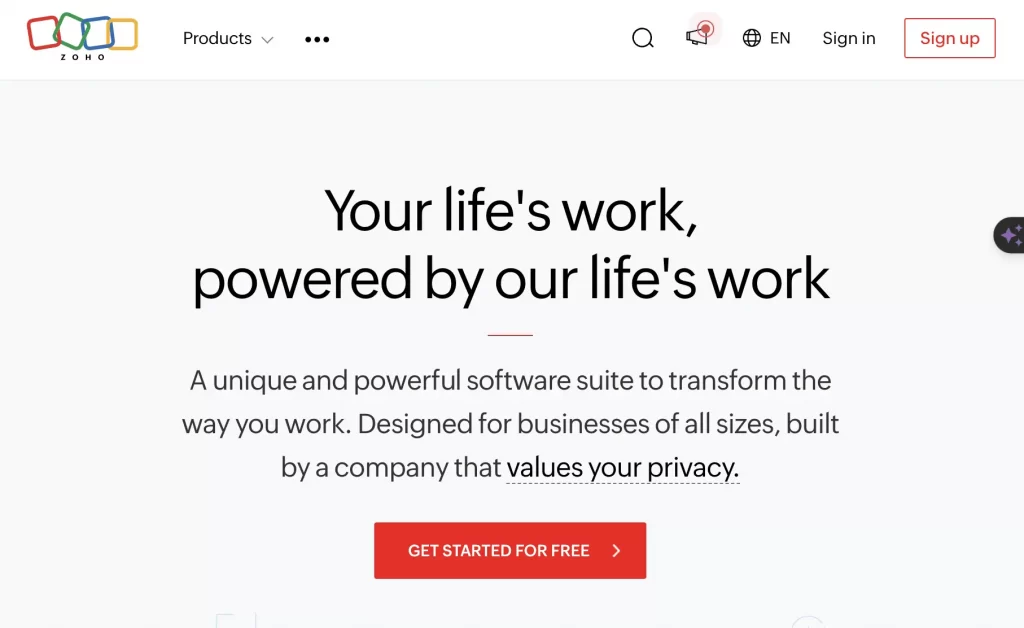
Multichannel Inventory Management – FAQs
What is multichannel inventory management?
Multichannel inventory management refers to the process of tracking and managing stock across multiple sales channels, such as top online marketplaces, eCommerce websites, brick-and-mortar stores, social media, and more.
Why does multichannel inventory and order management matter?
Multichannel inventory and order management matters because it keeps your stock and orders consistent across every platform you sell on. Without it, you risk overselling, stockouts, or shipping delays, all of which can hurt your customer experience and reputation.
What are the 4 types of inventory management?
The four main types of inventory are:
– Raw materials: The basic components used to create a finished product (e.g., fabric, metal, wood).
– Work-in-progress (WIP): Items that are currently being produced or assembled.
– Finished goods: Completed products that are ready to be sold to customers.
– Maintenance, repair, and operations (MRO) supplies: Materials and tools used to support production but not part of the final product (e.g., cleaning supplies, machinery parts).
Together, these categories help businesses track everything from production inputs to ready-to-sell items.
What are the 5 stages of the inventory management process?
The five main stages of the inventory management process are:
1. Inventory planning & forecasting: In this step, you need to estimate how much stock you’ll need based on sales trends and demand.
2. Purchasing & ordering: Then, based on your forecast, you buy the right products or materials from your suppliers.
3. Receiving & storing: Check incoming stock, organize it, and store it safely.
4. Tracking & control: This step focuses on keeping an eye on stock levels and updating them in real time to avoid errors.
5. Fulfillment & shipping: Finally, pick, pack, and deliver products to customers quickly and accurately as much as possible.
Each step helps you stay organized, avoid stock problems, and keep your customers happy.
Level Up Your Inventory Management Today!
So, whether you’re already selling on multiple platforms or planning to expand, manual tracking just isn’t enough anymore. Multichannel inventory management helps you stay organized, sync listings automatically, and keep customers happy across every channel. With an effective cloud-based system, you can save time, avoid costly mistakes, and grow your business confidently.
Ready to take your inventory management to the next level? Try using LitCommerce. This powerful multichannel selling tool lets you connect all your stores, sync inventory in real time, and manage all your orders in one dashboard. It’s the easiest way to simplify your workflow and scale your business efficiently.

